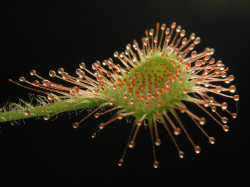Description
Drosera is a genus in the Droseraceae family of carnivorous plants. Members of this family lure, capture and digest insects to supplement the poor mineral nutrition they obtain from their native soils. They are known as sundews because their glandular leaf hairs glisten like dew in the sun. Flowers are held far above the leaves on a long stem. They open in response to sun.
Drosera rotundifolia (the common sundew or round-leaved sundew) is a species of sundew, a carnivorous plant often found in bogs, marshes and fens. One of the most widespread sundew species, it is generally circumboreal, being found in all of northern Europe, much of Siberia, large parts of northern North America, Korea, Japan and is also found on New Guinea. The leaves of the common sundew are arranged in a basal rosette. The narrow, hairy 1.3-5 centimetre long petioles support 4-10 millimetres long laminae. The upper surface of the lamina is densely covered with red glandular hairs that secrete a sticky mucilage. A typical plant has a diameter of around 3-5 centimetres, with a 5-25 centimetre tall inflorescence. The flowers grow on one side of a single slender, hairless stalk that emanates from the centre of the leaf rosette. White or pink in colour, the five-petalled flowers produce 1-1.5 mm light brown seeds that are slender and tapered.In the winter, D. rotundifolia produces a hibernaculum in order to survive the cold conditions. This consists of a bud of tightly curled leaves at ground level. The plant feeds on insects, which are attracted to its bright red colour and its glistening drops of mucilage, loaded with a sugary substance, that cover its leaves. It has evolved this carnivorous behaviour in response to its habitat, which is usually poor in nutrients or so acidic that nutrient availability is severely decreased. The plant uses enzymes to dissolve the insects - which become stuck to the glandular tentacles - and extract nitrates and other nutrients from their bodies.
USDA Zone - N/A
Season to Sow - N/A
Please familiarise yourself with the shipping info below
